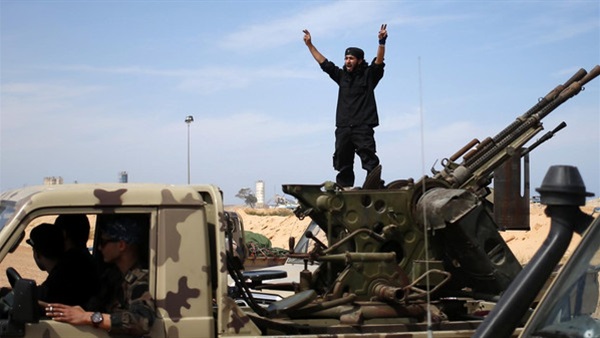Map of Jihadist and militant presence in Libya

The map of Takfiri group presence in Libya has undergone some change. Some groups have already disappeared. This was particularly true after the commander of the Libyan National Army, Khalifa Haftar, launched "Operation Dignity" in May 2014. Haftar staged the operation against extremist groups. The operation succeeded in liberating 80 per cent of Libyan territories by mid-2017, according to Haftar himself.
Having received one blow after another by Haftar's troops, especially in eastern Libya, Takfiri groups started employing new tactics. These tactics included the following:
First, leaving eastern Libya for the western part of the country where Haftar's troops have almost no presence. The same western part of the country is disputed by both the National Accord Government which is led by Fayez al-Sarraj and the National Salvation Government which is led by Khalifa al-Ghawil.
Second, dependence on sleeper cells which stage lone-wolf attacks.
The following militant groups have presence in Libya at present:
Groups active in eastern and central Libya
Darnah Jihadists' Consultative Council
This is one of the most outstanding Takfiri groups in the northeastern Libyan city of Darnah. The group was founded on December 12, 2014, soon after the launch of Operation Dignity. Several Takfiri groups joined the council, including Ansar al-Sharia, a militant group whose ideology is similar to that of al-Qaeda. Ansar al-Sharia was founded by Mohamed al-Zahawi in early 2012. It had presence in Darnah, Sabratha, Benghazi, Misurata, Tripoli and Sirte.
Al-Battar Brigade was also one of the groups that joined the council. The brigade is made up of a number of Libyan militants who fought in Syria and returned to their mother country.
The Abu Selim Martyrs Brigade also joined in. The brigade was founded by Salem al-Derbi in February 2011. Al-Derbi was killed in battles with Daesh in January 2015.
Elements of the Libyan Islamic Fighting Group also became part of the council. The group was officially declared in a border area between Pakistan and Afghanistan in 1990. It used some of its sleeper cells in Libya to fight against the late Libyan leader Muammar Gaddafi. The members of these cells then joined the council in October 2015 in the fight against Daesh.
The Darnah Jihadists' Consultative Council then morphed into several terrorist groups that include the following:
- Al –Mourabitoun
Commanded by sacked Egyptian army officer, Hesham Ashmawi, al –Mourabitoun is mainly present in Darnah where it trains militants and then sends them to Egypt. One of the militant groups it sent into Egypt staged an attack in Bahriya Oasis (around 365 kilometers west of Cairo). This group was commanded by sacked Egyptian army officer Emad Abdel Hamid.
It formed the Ansar Islam organization in August 2016, according to one of the members of the group who was arrested by the Egyptian army. The organization was based in the Egyptian Western Desert and planned a number of attacks inside Egyptian cities. Egyptian security forces succeeded in killing the members of the organization in October 2017, except for Libyan national, Abdel Rahim al-Mesmari.
Some of the members of al-Mourabitoun continue to be present in Darnah. They will try to move their activities to Egypt in the coming days, despite the presence of reports about the disbanding of the group. Smaller cells, some of them affiliated to al-Mourabitoun and others affiliated to the Darnah Jihadists Consultative Council, are also present in Darnah and in the central Jufra District. These cells are commanded by a leader of the Egyptian Salafist Front, according to sources.
- The Libyan Islamic Fighting Group
This group was founded in an area near the joint border between Pakistan and Afghanistan in 1990. It was founded by one of the members of the Islamic Group after he escaped a crackdown in Libya by the late leader Muammar Gaddafi in the 1980s. Other members of the group who escaped the same crackdown joined in groups fighting against the Soviet occupation of Afghanistan. Hardened by years of fighting in Afghanistan, the same militants officially formed the Islamic Group and brought sleeper cells in Libya back into action in the 1990s.
The group then claimed responsibility for some attacks that were staged inside Libya at the time. In 2007, the Libyan Islamic Fighting Group made reconciliation with Gaddafi's regime and declared ideological revisions. Nonetheless, the group went back to violent work soon after the eruption of the popular uprising against Gaddafi in February 2011.
The group is now mainly based in eastern Libya, specifically in Darnah, which has become the main stronghold of the group. The group also has some sleeper cells in Benghazi.
- The Benghazi Defense Units
These units were formed soon after the Benghazi Revolutionaries Consultative Council was vanquished by Haftar's troops and kicked out of Ajdabiya and Benghazi. The units formed the nucleus for the alliance of a number of Takfiri organizations that were defeated by Haftar's troops in 2017. These organizations included the Benghazi Revolutionaries Consultative Council and the February 17th Martyrs Brigade which combined 12 different militant groups and was founded by Fawzi Abu Ketf after the 2011 revolution.
The groups also included the Rafallah al-Sahati Brigade and the Ajdabiya Revolutionaries Consultative Council.
- Daesh sleeper cells
The Daesh-affiliated Islamic Youth Council, a group of foreign fighters and Ansar al-Sharia renegades, was founded by Suleiman al-Tajouri who was assigned by Daesh leader Abu Bakr al-Baghdadi to form the group in Darnah in October 2015. The promulgation of the council came after its fighters controlled Darnah and declared it an Islamic state in August 2014.
The organization then moved into Sirte to turn it into a new base. Nonetheless, it was destroyed by troops affiliated to the Fayez al-Sarraj National Accord Government.
Although Daesh's organizational structure is almost over and most of its leaders and militants killed, the organization still has presence in Benghazi and al-Bayda. Organization militants form a number of sleeper cells in the two cities.
Militias that back the National Accord Government





